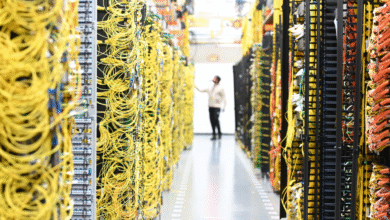Microbes Unlock Copper as AI Demand Soars

▼ Summary
– Copper scarcity poses the next major threat to internet infrastructure, surpassing concerns about disinformation or deepfakes.
– AI data centers are accelerating copper demand, with single facilities requiring thousands of tonnes for electrical systems and transmission lines.
– Traditional copper mining struggles with 70% of global reserves locked in complex ores, leaving billions of tons in waste piles untapped.
– Endolith uses AI-guided microbes to extract copper from low-grade ores through bioleaching, offering a cleaner and more efficient alternative to smelting.
– The physical limitations of copper supply are already causing AI infrastructure delays, highlighting the disconnect between technological ambition and material constraints.
The world’s accelerating demand for artificial intelligence is quietly fueling a global hunt for copper, the essential metal that powers every data center, transmission line, and piece of modern electrical infrastructure. While much of the conversation revolves around computational models and energy consumption, the physical reality is that accessible copper reserves are dwindling. Hyperscale data centers require staggering amounts of this conductive metal, with a single facility potentially needing tens of thousands of tonnes. A recent analysis from McKinsey suggests that by 2031, annual global copper demand could surge to approximately 37 million tonnes, driven significantly by the infrastructure build-out for AI and transmission networks.
This soaring demand is colliding with a critical supply challenge. More than 70 percent of the world’s known copper reserves are trapped within complex ores that conventional mining techniques struggle to process economically. Billions of tons of copper sit untapped in low-grade deposits and mining waste piles, overlooked by traditional industry but representing a vast reservoir of potential. This is the problem that led to the founding of a startup named Endolith, which is pioneering a novel solution: using specially selected microbes to liberate copper from these forgotten sources.
The process, known as bioleaching, leverages naturally occurring microorganisms that are highly effective at recovering copper from challenging ores like chalcopyrite and enargite. These microbes are deployed directly into leaching heaps at mining sites, where they thrive under real-world conditions. The significant advantage of this biological approach is its reduced environmental footprint. It consumes far less energy and yields more metal per tonne of ore processed compared to traditional methods.
Conventional copper extraction is a resource-intensive affair. It typically involves grinding rock into fine particles, concentrating the ore, and then employing high-temperature smelting or aggressive chemical leaching with powerful acids. These processes are not only slow and energy-hungry but also generate substantial waste and emissions. In stark contrast, Endolith’s “microbial minions” accelerate a natural geological process. They attach themselves to the ore and efficiently pull out the copper, adapting to the specific chemistry of different rock types to maximize recovery while minimizing ecological impact.
The key to making this biological system scalable and predictable is artificial intelligence. Researchers use machine learning models to analyze genomic and metabolic data from thousands of microbial strains. These AI-driven models predict which microbes will survive and thrive in specific, extreme ores and forecast their performance under varying environmental conditions. This intelligence guides the selection of microbial communities for each site, how they should be tuned initially, and how their composition should adapt over time. In a powerful feedback loop, AI is being used to optimize the biological recovery of the very copper that is needed to power further AI development.
Endolith’s approach has already garnered validation from major global copper producers, including industry giant BHP. The technology is designed for rapid deployment through modular “biohatcheries”, field units that can grow and deliver tailored microbes on-site within days. These units can be calibrated for local geology and climate, making copper recovery economically viable from deposits that were previously considered worthless. This innovation effectively unlocks a part of the supply chain that conventional mining has largely ignored.
Discussions about the future of AI infrastructure frequently overlook this fundamental material layer. The focus tends to be on computing costs and energy requirements, but copper forms the literal backbone of the entire digital ecosystem. The physical constraints of this metal become painfully apparent when data center projects face delays due to transformer shortages or when utilities cannot build power lines fast enough to support new computing loads. These are, at their core, copper supply problems.
Site engineers often express quiet concern about whether their physical wiring can handle the power demands of cutting-edge computing hardware. Software innovation can advance rapidly, but physical infrastructure is bound by the slow pace of geology and mining. New mines take decades to develop, and recycling efforts, while important, cannot close the gap alone. Smarter biological recovery represents a practical lever that can be pulled right now to ease the supply crunch.
Historically, bioleaching has faced criticism for its slow performance with tough ores and difficulties in scaling up. However, recent breakthroughs in microbial science and heap engineering are overcoming these historical limitations. By using AI to meticulously optimize microbial consortia, it is now possible to match the perfect biological agents to specific ore types, achieving success where older, cruder methods failed.
There exists a profound disconnect between technological ambition and material reality. The belief in a AI-driven future is widespread, but the physical systems required to support that future are lagging decades behind. Building something durable requires more than just venture capital and software code; it requires metal and smarter, more sustainable pathways to obtain it. If we wish to continue our technological ascent, we must pay close attention to the fundamentals, extraction, wiring, and chemistry. These unglamorous components rarely make headlines, yet they ultimately determine whether progress is even possible.
The AI era will not be sustained by excitement alone. It will be sustained by copper. The next great leap in securing this critical resource may very well come from the most ancient of engineers: microbes, tiny, resilient, and very much alive.
(Source: Spectrum IEEE)





